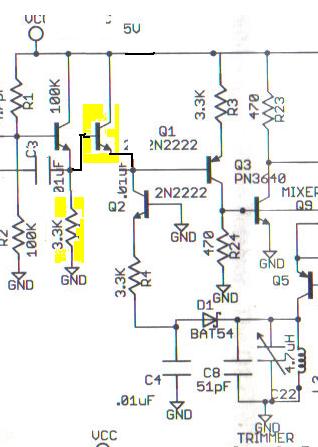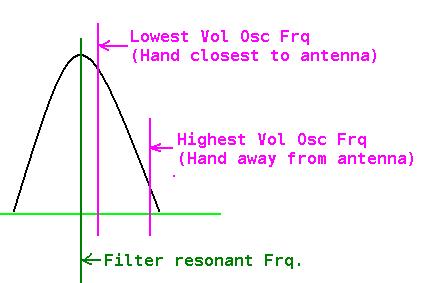Oh, one other thing I just noticed ;-) LOL..
"Worth to mention is the fact that connecting the center coil-tap to L2 causes the theremin to stop sounding at all. I keep it disconnected for that reason."
You have a problem there which needs sorting out..
L2 C5 forms an oscillator with Q4.. without the tap, there is no feedback path, and I cannot see how this oscillator can run..... Except for the fact that the frequency is so absurdly high anything is possible! ;-)
There is only one volume oscillator, no volume "reference" oscillator - the circuit of Q5 L3 C8 and C22 form a filter - this filter will be tuned to provide maximum amplitude at (i think) the highest frequency, and the amplitude will drop as the volume oscillator frequency drops.. But you need the volume oscillator to be running correctly to drive the filter.. and without the tap on L2 connecting via C7, I cannot see that it will run correctly, if at all!
There is absolutely no "crafting" in this design - the component values are absurd, C7 for example.. 10nF @15MHz ?? You could probably use a 10pF there quite happily! - the same is true for other capacitors - someone had a box of 10n's they wanted to use up! ;-)
It reminds me of a radio engineer I worked with in my youth - Whenever there was an unknown capacitor, he would tell me to "stick a .1 in" LOL ;-) .. in most cases it worked! But occasionally there was a puff of smoke from some "unrelated" component!
IMO, its really not worth spending too much time on this circuit unless you are doing so for educational / exporation reasons - and its one of those circuits which will teach you nothing about good electronics practice.
Forget about the sound - get the volume circuit working so that uou can see a change in voltage on C4.. perhaps even disconect C2 and C10 to disable these oscillators while you do that.. this removes possible causes of confusion.
Once you have the volume voltage showing, then re-enable the oscillators.
I really do want to understand why you chose this circuit! There are no details regarding the inductors for example - How did you determine where to put the taps or what to wind them on ? .. They are tunable inductors - Even I wouldnt venture to obtain formers and wind these coils unless I had extremely good reason to do so - And I wouldnt have any idea where to obtain ready built parts!
This circuit is more complex than the EM theremin designed by Bob Moog - The EM would be easier to build, components would be easier to find, and you would end up with a good playable instrument..
In order to have got the circuit to operate to the degree you did means that you must have sourced or wound your own inductors - You must therefore have quite a high degree of electronics competence..
And I just dont understand it! Why did you pick this awful circuit ??? I really am not trying to pick a fight or give you an earbashing - I am trying to understand... You see, I believe nobody does anything without believing their choice is a good one - So perhaps I am wrong, perhaps there was good reason which I cannot see.
Fred.




